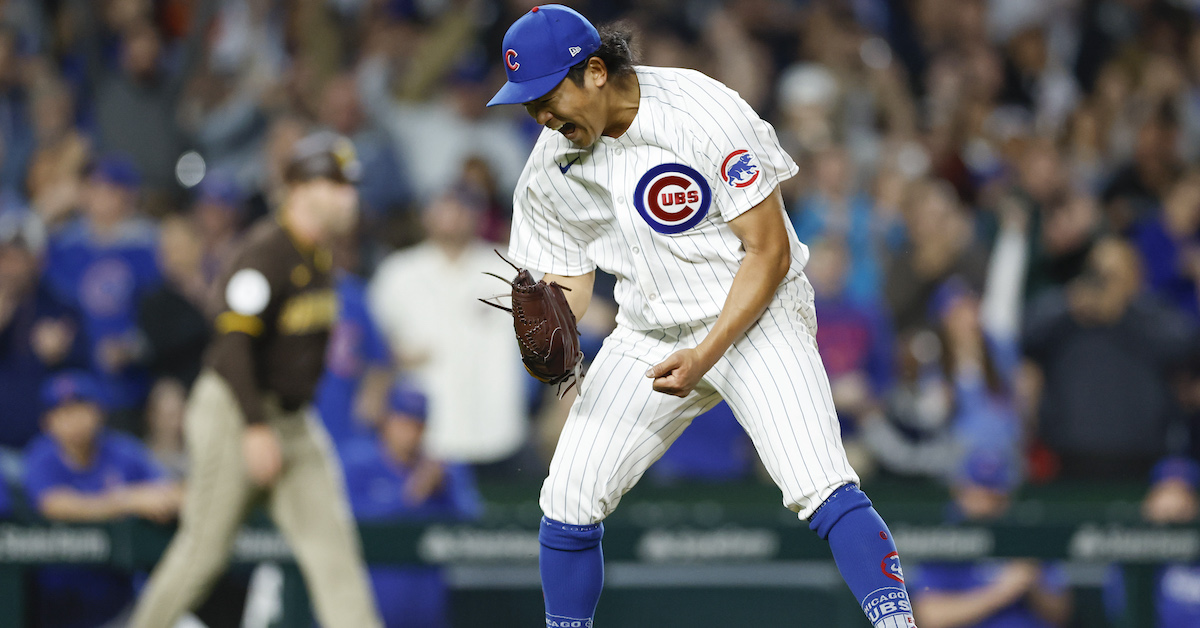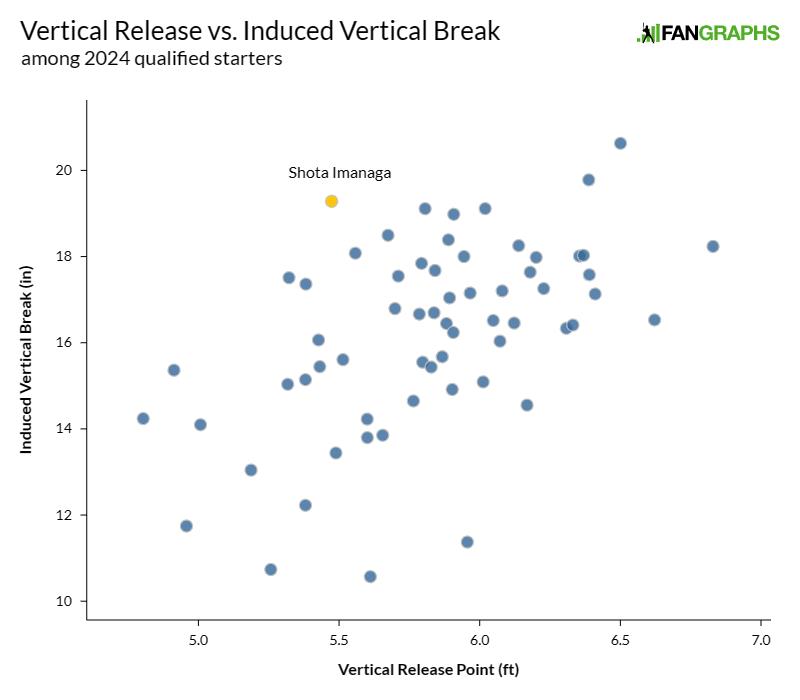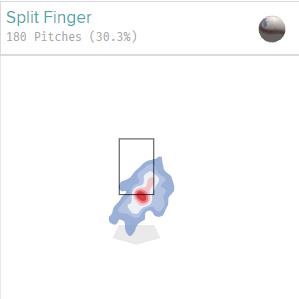
Kamil Krzaczynski-USA TODAY Sports
Among the crowd of high-end starting pitchers to sign with new teams over the offseason, perhaps none had wider error bars surrounding his projection than Shota Imanaga. An NPB star for the past half-decade, Imanaga had a track record of success but also many questions about how his skills would translate to MLB. This certainly is reflected in his contract with the Cubs, which came with just two guaranteed years worth $23 million, a far cry from our $88 million estimate. But for the past month and change, the 30-year old rookie has been up there with the league’s best.
Shota Imanaga’s Stat Rankings
| K% |
BB% |
ERA |
xERA |
FIP |
| 18th |
4th |
1st |
4th |
8th |
out of 79 qualified pitchers
Through his first seven starts, Imanaga has allowed just five earned runs, fewest among qualified pitchers. He’s been downright dominant through much of this stretch, proving his stuff is up to major league standards while controlling the strike zone better than almost anyone else. But he’s done so differently than other top pitching talents. Let’s take a look at his pitch arsenal.
From a quick glance at the stat sheet, the first thing that catches my eye is the sheer frequency with which Imanaga uses his fastball. In an era where nearly two-thirds of starters throw non-fastballs a majority of the time, Imanaga’s 58.4% usage (91st percentile) stands out. As pointed out by MLB.com’s David Adler, Imanaga’s heater has been the best individual pitch in baseball by run value, beating out Corbin Burnes’ notorious cutter Tyler Glasnow’s frightening fastball. But while the other heaters at the top of this list sit in the mid- to upper-90s, Imanaga’s four-seamer averages just 92 mph.
The list of starters who sit at 92 or below is rather short, and mostly consists of names that we certainly don’t think of as strikeout artists. In his piece, Adler noted that Imanaga’s fastball has elite induced vertical break (IVB). But carry alone doesn’t always make a fastball effective; Triston McKenzie’s four-seamer, which currently leads the league in fastball IVB, has the highest xwOBA allowed of any such pitch (min. 50 plate appearances). Rather, what makes Imanaga’s offering so special is its plus movement in combination with its ultra-low release point.

Pitchers like McKenzie and Ross Stripling throw from high, over-the-top arm slots, making their backspin (and thus vertical movement) predictable for hitters. In contrast, Imanaga’s delivery from a low three-quarters slot creates a movement profile much different than what you’d expect from his arm angle. Earlier this week, Michael Rosen broke down the biomechanics of Imanaga’s ability to spin the ball so well from an outlier release point, showing how his hip and lower-body flexibility enable him to “get behind” the ball and create backspin. Throughout the league, no starter gets a higher IVB than Imanaga does from such a low release point – those throwing from lower slots are primarily sidearmers whose deliveries generate run at the expense of carry, while the only two hurlers with more IVB (min. 250 four-seamers), McKenzie and Tyler Anderson, have release points about a foot higher.
Because of its low release point and high carry, Imanaga’s four-seamer has the third-shallowest vertical approach angle in baseball, creating the deception that causes batters to swing under it with surprising frequency. Its 12.5% swinging strike rate and 22.1% putaway rate easily exceed the league averages of 10.3% and 17.9%, respectively, as he’s able to throw it for a whiff in any count.
Imanaga gets more fastball whiffs than most, but his swinging strike rate with the pitch is a far cry from Jared Jones’ league-leading 20.1%. To be the most valuable pitch in baseball, Imanaga’s fastball has to work even when he’s not blowing it past hitters. And at first glance, you might think that a low-90s heater that lives in the zone would get sent a long way when batters connect with it. Indeed, homers were the one knock on Imanaga’s game in NPB, as his 2.9% homer rate (1.04 HR/9) last year was highest in the league in a deadened offensive environment. But he’s allowed just three homers across his seven MLB starts, and the Statcast data indicate this low total is more a product of skill than luck.
Fastball Contact Quality Metrics
| Statistic |
Value |
Percentile |
| wOBA |
.189 |
98th |
| xwOBA |
.279 |
85th |
| Barrel Rate |
7.6% |
66th |
SOURCE: Baseball Savant
I’m not saying that a 0.65 HR/9 represents Imanaga’s true talent (ZiPS forecasts a 0.94 mark for the rest of the year), and it’s certainly likely that the results will regress toward his xwOBA as the season goes on, but he’s clearly been keeping pitches away from barrels at an above-average clip, a skill that many evaluators were skeptical of as he made the leap to MLB. Part of this is due to his fastball’s shape – a flat VAA can lead to uncomfortable swings and produce weak outs. While this type of fastball does contribute to a high fly ball rate, opponents haven’t been able to put a charge into their aerial hits thus far. Imanaga’s average exit velocity and hard-hit rates allowed sit around the league average, but his exit velocity allowed on batted balls in the air is a much more favorable 70th percentile. He also has the ninth-lowest line drive rate among qualified starters, almost never allowing squared-up contact.
Imanaga also locates his fastball in places unlikely to produce barrels. Sure, he throws more heaters in the zone than almost anyone else, but he’s not just sending them down Broadway and hoping for the best; instead, he’s consistently hitting his spots at the top edge of the zone. He ranks 10th in fastballs thrown in the upper third of the zone, an area where the flatness of the pitch can play up and create the illusion that it’s rising. Unsurprisingly, his Kirby Index, a stat that measures release angle consistency, ranks in the 90th percentile.
Imanaga’s fastball alone has made him one of the most effective pitchers in the league, and I haven’t even talked about his plus splitter yet. Like the fastball, this is a pitch he throws with remarkable accuracy. Splitters are hard to command – many pitchers’ splitter heatmaps look like giant blobs, and nearly 14% of splitters are wasted, the second highest of any pitch type. But Imanaga repeatedly hits the area at the bottom of and just below the strike zone, an optimal spot for success. His splitter has a 108 Location+ and 57 PitchingBot command grade, both among the league’s highest.

From a pure shape perspective, Imanaga’s splitter doesn’t particularly stand out. It doesn’t have absurd lateral movement like Kevin Gausman’s or fall off the table like Jordan Hicks’; Imanaga’s actually drops a few inches less than average. But when paired with his high fastball, that splitter becomes downright nasty. Thrown from the same release point and angle as his heater, Imanaga’s splitter gets hitters to swing at what they think is a meaty fastball before they have time to realize that the pitch is 9 mph slower and 19 inches lower. He throws it only about half as often as his heater, saving the split for two-strike counts where hitters are in swing mode. And swing they do, coming up empty nearly half the time they offer at it. The end result is that Imanaga’s splitter is one of the best whiff pitches in the league.
Best Whiff Pitches in Baseball
SOURCE: Baseball Savant (min. 50 PA)
The splitter has also been integral in maintaining Imanaga’s minuscule walk rate, as hitters swing and miss at them before they can work themselves into deep counts. Opponents have swung at 47.2% of the out-of-zone splitters he’s thrown, a huge reason his overall chase rate nearly tops the charts. His low walk rate and refusal to waste pitches has worked wonders in terms of efficiency, averaging the sixth-fewest pitches per inning among qualified starters. Imanaga’s quick work of opposing lineups has allowed him to pitch deep into games (averaging six innings per start) while acclimating to more frequent outings as part of a five-man rotation.
Just a month into his MLB career, Imanaga has exceeded all expectations and emerged as an ace. His brilliant pitch execution hasn’t just proven what he can be at his best, they’ve also calmed concerns about what his downside risk can look like. When he signed, it was easy for skeptics to compare him to other hurlers without big velocity and forecast doubt. But Imanaga has shown that nobody else pitches the way he does.
Source
https://blogs.fangraphs.com/shota-imanaga-is-pitching-like-an-ace/
 Backyard GrillingWeekend WarriorsAdvice from DadBeard GroomingTV Shows for Guys4x4 Off-Road CarsMens FashionSports NewsAncient Archeology World NewsPrivacy PolicyTerms And Conditions
Backyard GrillingWeekend WarriorsAdvice from DadBeard GroomingTV Shows for Guys4x4 Off-Road CarsMens FashionSports NewsAncient Archeology World NewsPrivacy PolicyTerms And Conditions
